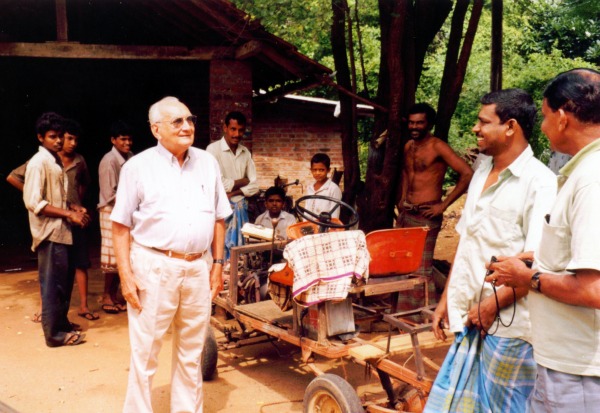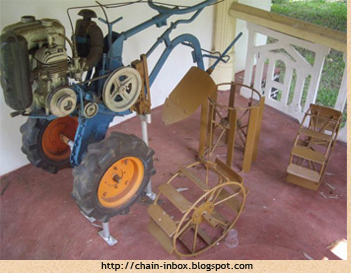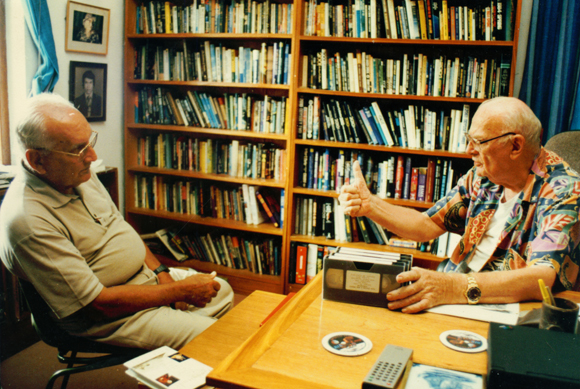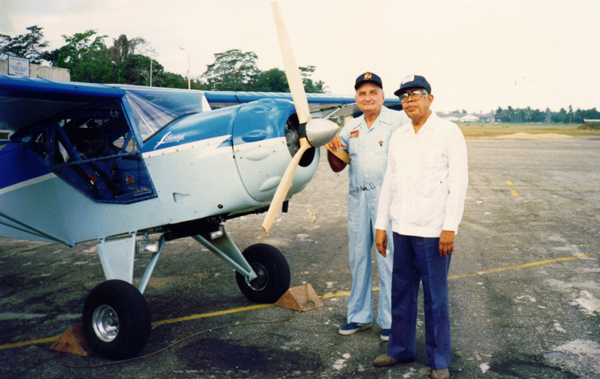Invention and Innovation

"When I am working on a problem, I never think about beauty. I only think about how to solve the problem. But when I have finished, if the solution is not beautiful, I know it is wrong."
- Richard Buckminster Fuller (1885-1983)
These words, by one of Ray Wijewardene’s own mentors, neatly sum up a philosophy both men shared: good innovation combines functionality, design elegance and societal benefit.
Ray was the quintessential ‘tinkerer’: his life-long quest was to solve practical problems and improve the quality of life -- for himself, those around him, and society at large. In that process, he went back to Nature and evoked the first principles of physics; he asked more questions than he could immediately answer; he got his hands dirty in endless experimentation; and he was never afraid to make mistakes -- or to go against conventional wisdom.
 The best known example of Ray’s innovation is the Land Master (1955) -- the world’s first two-wheeled hand tractor intended to help small farmers in the tropics to mechanise their field work. He later acknowledged that he started off with the two-wheeled garden tractor and re-designed it. The standard tractors at the time were large, expensive and involved high maintenance. He then designed a combined harvester and some add-ons.
The best known example of Ray’s innovation is the Land Master (1955) -- the world’s first two-wheeled hand tractor intended to help small farmers in the tropics to mechanise their field work. He later acknowledged that he started off with the two-wheeled garden tractor and re-designed it. The standard tractors at the time were large, expensive and involved high maintenance. He then designed a combined harvester and some add-ons.
During his international assignments -- first in Malaysia and later in Nigeria -- in the 1970s, Ray experimented with a number of devices and processes all ultimately aiming to improve working conditions for small farmers in the tropics. These included a tractor-like seeding machine, mini paddy harvesters, and a controlled droplet spray unit.
For many years, Ray was interested in human-powered modes of transport – ranging from bicycles to hand-gliders. He exchanged ideas and designs with people all over the world who were working on a shared goal: a faster, safer and easier-to-ride bicycle!
 Sadly, the ‘Do-It-Yourself’ tradition never really emerged in Sri Lanka -- purchasing from a shop was easier! As a result, we have produced generations of engineers and technicians who are excellent on theory, but a bit weak when it comes to practical aspects of problem solving! Sadly, the ‘Do-It-Yourself’ tradition never really emerged in Sri Lanka -- purchasing from a shop was easier! As a result, we have produced generations of engineers and technicians who are excellent on theory, but a bit weak when it comes to practical aspects of problem solving! - Ray Wijewardene |
Ray’s experiments with systemic challenges like renewable energy and soil conservation gathered momentum after he returned to Sri Lanka in 1980. Whatever the specific need, he always read and consulted widely before trying out his own innovations. Sometimes he gladly abandoned his design if a better one was proposed by someone else.
Ray also nurtured fellow inventors in his private capacity, and for a while as the head of Sri Lanka’s National Inventors Commission. He did so with an inquisitive, open and accommodating mind. He never probed the educational qualifications or social status of an inventor. Instead, he weighed each idea on its own merit.
He was a firm believer in the trial-and-error method of perfection. He also recognised that innovation is a long-drawn process that could not be driven by bureaucrats or businessmen.
Ray especially knew the serious limits of ivory tower universities and formal research institutes when it comes to nurturing innovation. Although he saw some value in governments and industry funding research, he did not want ‘bean-counters’ placed in charge of discovery or invention. He was fond of quoting his friend Sir Arthur C Clarke’s words: "If there had been government research establishments in the Stone Age, we would have had absolutely superb flint tools. But no one would have invented steel."

If innovation and imagination are so intangible, how can governments and societies encourage their pursuit? Another of Ray’s friends, the renowned biochemist Professor Cyril Ponnamperuma, preferred this approach: "Find the best young minds, give them all facilities, set them goals -- and then leave them alone!"
When he was founder director of the Arthur C Clarke Centre for Modern Technologies in the mid 1980s, Ponnamperuma launched a ‘Science for Youth’ programme. Every year, 30 of the brightest high school leavers were selected a nationally competitive basis, and exposed to modern technologies over six consecutive weekends. Ray was closely associated with this activity, which inspired the Computer Society of Sri Lanka (now a professional body) and the Young Astronomers’ Association (now defunct).
Ray later recalled the experience: “I was privileged to take the youngsters for what became known as ‘Innovators Day’. Both Cyril and Arthur would join me during the day for an hour or two of chat, which included outings to Bolgoda Lake for lunch and an experience with yachting (my main sporting interest at the time) and also at our hangar at the airport where our range of experimental ‘human-powered-vehicles’ was available for them to ride.”

For further discussion, see:
Ray Wijewardene, the Thinker and Tinkerer
by Nalaka Gunawardene
![]() My friend Arthur C Clarke
My friend Arthur C Clarke
Ray Wijewardene fondly recalls 40 years of friendship with Sir Arthur C Clarke in pursuing fresh thinking and innovative solutions (essay written in 2005)

